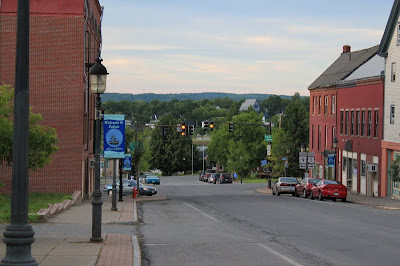Calais (pronounced callous) Maine is the largest community of 44 in the county. It was incorporated as a town in 1809 and as a city in 1851. Moosehorn NWR is 7 miles north of Calais.
When at Santa Ana NWR, we can look across into another country. While at Moosehorn NWR we can look into another country. However venturing into Canada, we don't have the same trepidation.
This is entering town on US 1, which follows the St. Croix River that separates the US from Canada. Turning left, you would be going into Canada via the bridge. Going straight would take you to the river where you can access a walking path that parallels the river.
You can see in the background the bridge that crosses into St. Stephen where the Ganong Chocolate Factory is located. Calais is kept alive with the Canadians coming here to shop.
Along with the lumber industry, Calais also developed as a ship building center and became a boom town. Many of the beautiful old homes were owned by the people engaged in these businesses. You can see from the picture above where some of the old wharves used to be.
This is the oldest house in Calais built in 1805. It is known as the Holmes Cottage/Museum.
This is the library which was built in 1892.
Every Tuesday evening in the summer, there is live entertainment on the Village Green...no charge.
There is a very nice visitor center which is run by the Passamaquoddy Indian Tribe. There is free wi-fi, and downstairs are displays where you can learn more about the tribe.
This is a display of some of the hand made sweet grass baskets. The picture below is right across from the Village Green, depicting the main drag.
Dr. Thomson's Sarsaparilla....cures when others fail!!!
Hum, I wonder if there is any truth to that??
Now, back to the Red Beach area of town. It's called Red Beach because of the red granite that used to be quarried here.
On this island was where the first European settlement North of Florida was established in 1604. It lies in the middle of the St. Croix River making it an International Historic Site. They found the Passamaquoddy tribe to be friendly and willing to trade. This picture is taken during low tide.
The settlers, led by Pierre Dugua and Samuel De Champlain, had a disastrous winter here during which many of the settlers died. There was a total of 78 men, 35 of whom died. They became trapped on the island because of the severe winter, freezing the water and then the tides would break up the ice, making it impossible to cross to the mainland. They ran out of fresh water and food.
The island was named by Dugua because the intersection of tributaries upriver appeared to form a cross.
Passamaquoddy means People of the Dawn.
I left out one of the mottos in our last blog:
State Motto: Dirigo....I lead!!
Hope you enjoyed your tour of Calais. If you pronounce it calay, they know your from away.
















No comments:
Post a Comment